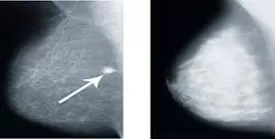The Pink Journey Foundation
Understanding Breast Density
Introduction:
Breast density is a major risk factor for developing breast cancer (Ref. 1-2). Most women under the age of 50 have dense breasts. As women age their breasts tend to get less dense. It is estimated that a third of all women in their 70s will have dense breasts (Ref. 3).
It is important for women to understand that breast density cannot be determined on
self-examination or with a clinical exam. The only way to determine a woman’s density status is to perform a mammogram.
Breast density makes it more difficult to detect small breast cancers on the screening mammogram. Women with dense breasts are also at an increased risk of developing breast cancer as compared to women whose breasts are not dense (Ref. 4). Because of these two factors, women with dense breasts are advised to have additional yearly breast imaging. Women with a strong family history are advised to have a yearly breast MRI. Women who have no other risk factors such as a strong family history are advised to have an additional bilateral breast screening ultrasound. (Link to our screening guidelines).
Understand breast density
The breast is composed of both fatty tissue and dense fibro-glandular tissue. Fatty tissue is black on the mammogram and breast cancers are white. Even small white breast cancers are easily detected in women whose breasts are primarily composed of black fatty tissue. The situation is reversed in women with dense breasts. Fibro-glandular tissue is white and small cancers are white. This lack of contrast makes it much more challenging to detect a small cancer in women with dense breasts.
The Mammogram Report: (Ref. 5)
The mammogram classifies breast density into 4 separate categories. The first two categories are referred to as fatty breasts. There are two types of fatty breasts. One type is labeled as “fatty” in which there is no visible fibro-glandular tissue. The second pattern is labeled as “scattered fibro-glandular density”.
The next two categories are classified as dense breasts and are also subdivided into two categories: “heterogeneously dense and extremely dense”. In general, the greater degree of density the higher the risk of developing breast cancer as well as the greater the risk of failure to detect small breast cancers.
An example of the challenge of detecting small breast cancers in a woman with dense breasts is illustrated in Figures 2 and 3. Figure 2 shows a small white breast cancer in a woman who has a fatty breast pattern. The white cancer is easily detected in a breast with fatty breasts (see arrow). Figure 3 is a mammogram of another woman who has a similar-sized breast, but it is extremely dense. The small breast cancer noted in Fig. 2 could easily be obscured by the surrounding tissue making it extremely difficult to visualize in Fig.3.
Questions? Contact Us.
References:
- Dense Breasts’ Eclipse All Other Known Breast Cancer Risk Factors
https://www.ucsf.edu/news/2017/02/405711/dense-breasts-eclipse-all-other-known-breast-cancer-risk-factors - Dense Breasts: Answers to Commonly Asked Questions
https://www.cancer.gov/types/breast/breast-changes/dense-breasts - The relationship of mammographic density and age: implications for breast cancer screening
https://pubmed.ncbi.nlm.nih.gov/22358028/ - Women with Dense Breasts Have a Higher Risk of More Aggressive Cancers
https://www.breastcancer.org/research-news/20110801 - Breast density — The four levels
https://www.mayoclinic.org/breast-density-mdash-the-four-levels/img-20008862

